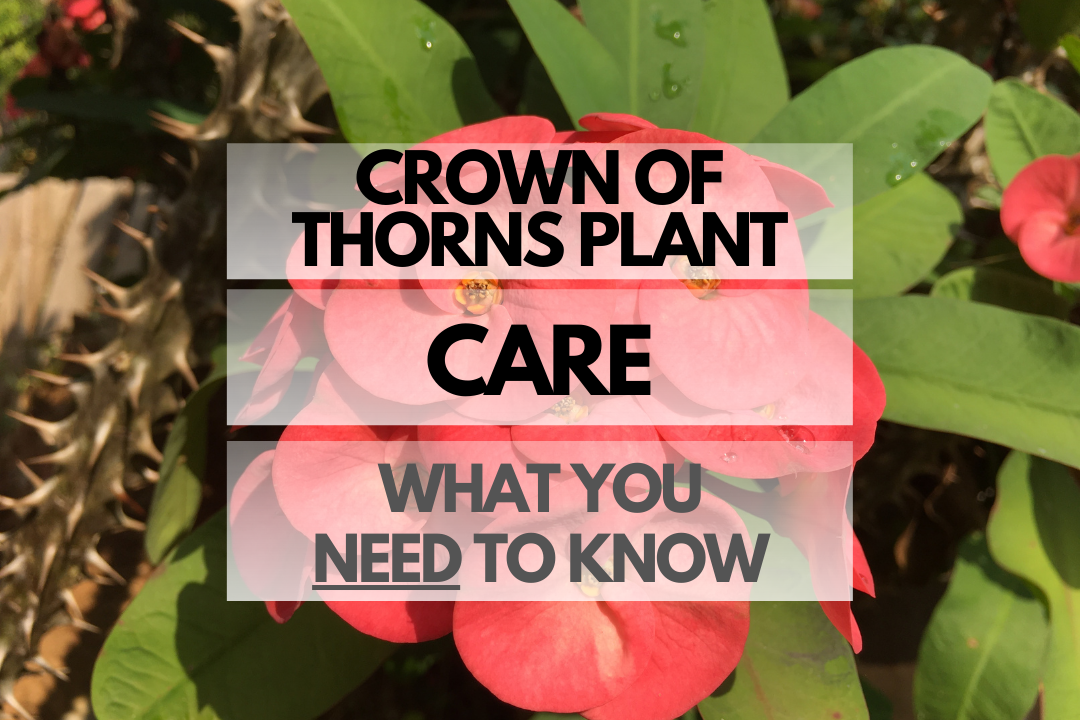Discover the secrets to successful Crown of Thorns Plant care with this comprehensive guide. We’ll cover everything from sunlight requirements to optimal soil conditions, ensuring your plant thrives both indoors and outdoors. So let’s dive in and explore the fascinating world of Crown of Thorns Plant care!
Crown of Thorns Plant Care Guide
Quick Reference Table: Caring for Crown of Thorns Plant
| Aspect | Recommendation |
|---|---|
| Light | Full sun to partial shade |
| Soil | Well-draining, sandy or loamy soil; pH 6.0-7.5 |
| Watering | Allow soil to dry between waterings; reduce frequency in winter |
| Pruning | Prune as needed to maintain shape and remove dead or damaged growth |
| Temperature | Minimum temperature of 50°F (10°C); prefers warmer temperatures |
Crown of Thorns Plant Sunlight: Do They Need It and How Much?
Crown of Thorns Plants thrive in full sun to partial shade. Ideally, they should receive at least 4-6 hours of direct sunlight per day. However, they can tolerate lower light levels when grown indoors near a bright window. If your plant is not receiving enough light, it may become leggy and produce fewer flowers.
Crown of Thorns Plant Soil Tips
These plants prefer well-draining, sandy or loamy soil with a pH between 6.0 and 7.5. A mixture of equal parts potting soil, coarse sand, and perlite or pumice works well. Ensure the soil drains quickly to prevent root rot, which can occur if the plant sits in soggy soil for extended periods.
Crown of Thorns Plant Watering and Frequency
Water your Crown of Thorns Plant sparingly, allowing the soil to dry out between waterings. Overwatering can lead to root rot and other problems. In the summer months, water your plant every 7-10 days, while in the winter, reduce watering to every 3-4 weeks. Always use a well-draining container to prevent waterlogged soil.
Pruning Crown of Thorns Plant Properly
Prune your Crown of Thorns Plant as needed to maintain its shape and remove any dead or damaged growth. Regular pruning can also encourage bushier growth and more flowering. When pruning, be sure to wear gloves and protect your skin from the plant’s milky sap, which can be irritating to some people.
Optimal Crown of Thorns Plant Temperature: Can They Tolerate the Cold?
Crown of Thorns Plants prefer warmer temperatures and cannot tolerate prolonged exposure to temperatures below 50°F (10°C). If you live in a region with cold winters, grow your plant in a container and bring it indoors during the colder months. Place it near a bright window and maintain a consistent temperature to keep your plant healthy and happy.
Common Crown of Thorns Plant Problems
Milky Sap Irritation
When pruning or handling your Crown of Thorns Plant, take care to avoid contact with the milky sap, which can cause skin irritation and even temporary blindness if it comes into contact with your eyes. Always wear gloves and wash your hands thoroughly after handling the plant.
Root Rot
Overwatering can lead to root rot, a potentially fatal condition for your plant. To avoid root rot, allow the soil to dry out between waterings and ensure your plant is in a well-draining container. If you notice signs of root rot, such as yellowing leaves or a foul smell, you may need to repot your plant in fresh, well-draining soil.
Pests
Crown of Thorns Plants can be susceptible to pests like spider mites, mealybugs, and aphids. Check your plant regularly for signs of infestations, and treat with insecticidal soap or neem oil as needed.
Crown of Thorns Plant Outdoors vs Indoors
Crown of Thorns Plants can be grown both indoors and outdoors, depending on your climate and preferences. Here’s a quick comparison of the pros and cons of each option:
| Pros | Cons |
|---|---|
| Indoors | Outdoors |
| Protection from cold temperatures | More susceptible to pests |
| Improved air quality | May require more frequent watering |
| Easier to control growing conditions | Less control over sunlight and temperature |
| Outdoors | Indoors |
| More natural sunlight | May require supplemental lighting |
| Can grow larger and healthier | Limited space for growth |
| More resilient to pests and diseases | Potential for indoor pests |
Best Pots for Crown of Thorns Plant
When selecting a pot for your Crown of Thorns Plant, opt for a container with drainage holes to prevent waterlogged soil and root rot. Terracotta pots are an excellent choice as they are porous and allow the soil to dry out more quickly. Alternatively, you can use plastic or ceramic pots with drainage holes, but be sure to monitor the soil moisture levels closely to avoid overwatering.
Crown of Thorns Plant Facts
Crown of Thorns Plant Benefits
- Air purification: Like many other indoor plants, Crown of Thorns Plants can help remove indoor air pollutants and improve overall air quality.
- Low-maintenance: These plants are easy to care for, making them an excellent choice for both beginner and experienced gardeners.
- Decorative appeal: With their attractive foliage and colorful flowers, Crown of Thorns Plants can brighten up any indoor or outdoor space.
Growth Rates: How Fast Do They Grow?
Crown of Thorns Plants are relatively slow-growing, typically reaching a mature height of 2 to 3 feet over several years. The growth rate may vary depending on factors such as light, temperature, and growing conditions. In general, providing optimal care will help ensure healthy growth and development.
Crown of Thorns Plant Lifespan
When properly cared for, Crown of Thorns Plants can live for many years. Some specimens have been known to live up to 15 years or more. By providing the right growing conditions and addressing any problems that may arise, you can help ensure the longevity of your plant.
Are Crown of Thorns Plants Safe?
While Crown of Thorns Plants are not typically considered toxic, their milky sap can cause skin irritation and even temporary blindness if it comes into contact with the eyes. It’s essential to handle the plant with care and keep it out of reach of children and pets.
Crown of Thorns Plant Flowers
Crown of Thorns Plants produce small, colorful flowers surrounded by showy bracts. The flowers can be red, pink, yellow, or white, and they bloom throughout the year, with peak blooming periods in spring and summer. The vibrant flowers make these plants an attractive addition to any garden or indoor space.
Crown of Thorns Plant Types and Varieties
Euphorbia milii
Euphorbia milii, also known as the classic Crown of Thorns Plant, is characterized by its green, spiny stems and vibrant red, pink, or yellow flowers. This variety can grow up to 3 feet tall and is well-suited to both indoor and outdoor cultivation.
Euphorbia milii var. splendens
This variety, sometimes called the Giant Crown of Thorns, has larger flowers and thicker stems than the classic Euphorbia milii. The flowers are typically red, and the plant can grow up to 6 feet tall when grown outdoors.
Crown of Thorns Plant Pros and Cons
| Pros | Cons |
|---|---|
| Low-maintenance | Milky sap can cause skin irritation |
| Attractive flowers and foliage | Slow-growing |
| Can help purify indoor air | May require supplemental lighting when grown indoors |
Crown of Thorns Plant Cost
The cost of a Crown of Thorns Plant can vary depending on factors such as size, age, and availability. Typically, small plants in 4-inch pots can be found for around $5 to $10, while larger, more mature plants can cost $20 or more. Specialty or rare varieties may be more expensive.
Where to Buy Crown of Thorns Plant
Crown of Thorns Plants can be purchased at local garden centers, nurseries, or online retailers. When buying a plant, be sure to select a healthy specimen with no visible signs of damage or disease.
Is Crown of Thorns Plant Propagation in Water Possible?
While Crown of Thorns Plant propagation is typically done through stem cuttings in soil, it is also possible to propagate the plant in water. To do so, take a stem cutting, remove the lower leaves, and place the cutting in a container of water. Change the water regularly to prevent bacterial growth, and once roots have developed, transplant the cutting to a pot filled with well-draining soil.
Additional Resources
- Missouri Botanical Garden Plant Finder – A reliable source of information on Crown of Thorns Plant care and cultivation.
- University of Arkansas Extension – Offers helpful information on growing and caring for Crown of Thorns Plants.
- Houseplant Hobbyist Facebook Group – A community of houseplant enthusiasts where you can ask questions and share tips on Crown of Thorns Plant care.
FAQ for Crown of Thorns Plant Care
Are Crown of Thorns Plants toxic to cats?
While not considered highly toxic, the milky sap of Crown of Thorns Plants can cause skin irritation and gastrointestinal upset if ingested. It’s best to keep the plant out of reach of cats and other pets.
Are Crown of Thorns Plants toxic to dogs?
Similar to cats, the milky sap of Crown of Thorns Plants can cause skin irritation and gastrointestinal upset if ingested by dogs. Keep the plant out of reach of your pets to prevent any issues.
Are Crown of Thorns Plants toxic to kids?
Although not highly toxic, it’s still wise to keep Crown of Thorns Plants out of reach of children due to the potential for skin irritation and gastrointestinal issues if the sap is ingested.
How tall do Crown of Thorns Plants get?
Crown of Thorns Plants typically reach a mature height of 2 to 3 feet, though some varieties can grow up to 6 feet tall.
Can Crown of Thorns Plants live outside?
Yes, Crown of Thorns Plants can be grown outdoors in suitable climates. They thrive in USDA hardiness zones 9 through 11 and require well-draining soil, bright sunlight, and protection from freezing temperatures.
Are Crown of Thorns Plants poisonous?
While not considered highly poisonous, the milky sap of Crown of Thorns Plants can cause skin irritation and gastrointestinal issues if ingested. Handle the plant with care and keep it away from children and pets.
How often should I water my Crown of Thorns Plant?
Water your Crown of Thorns Plant when the top inch of soil feels dry to the touch. Be careful not to overwater, as these plants are susceptible to root rot if kept too wet. It’s generally better to underwater than overwater.
In conclusion, Crown of Thorns Plants are low-maintenance, attractive plants that can make a great addition to any indoor or outdoor space. By providing the right care and addressing any potential issues, you can enjoy these beautiful plants for many years to come.

